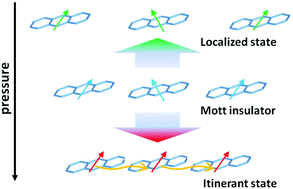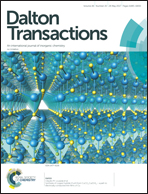Crossover from localized to itinerant states in hydrocarbon Mott insulators
Abstract
Crossover from an itinerant state to an isolated electronic state in electron-doped polycyclic aromatic hydrocarbon (PAH) was studied for the two smallest zigzag-type molecules of naphthalene (NN) and anthracene (AN) by focusing on their 1 : 1 stoichiometry, A1(NN) and A1(AN), with alkali metals (A = K and Rb). The competition between on-site Coulombic repulsion energy (U) and bandwidth (W) was argued in terms of their magnetic and electrical properties upon lattice expansion, when A varies from K, with a smaller ionic radius, to Rb, with a larger ionic radius. The temperature-dependence of magnetic susceptibility shows a pronounced hump associated with antiferromagnetic (AFM) interactions for Rb1(NN), being similar to those of K1(NN) and K1(AN) in the earlier report. On the other hand, Rb1(AN) intriguingly exhibits paramagnetic susceptibility, observed in a nearly localized electron system, being apart from an highly correlated Mott insulating state. Crystal structural analyses of the X-ray diffraction profiles show a small difference in lattice parameters of the ab plane among K1(NN), K1(AN), and Rb1(NN), whereas Rb1(AN) exhibits a significantly larger value than those of the others, being indicative of greatly modified interaction energies. The different magnetic properties observed in Rb1(AN) are interpreted from its modified intermolecular distance. The possibility of an emergent metallic state of K1(AN) under high pressure has also been described, referring to electrical transport measured under high pressure.



 Please wait while we load your content...
Please wait while we load your content...